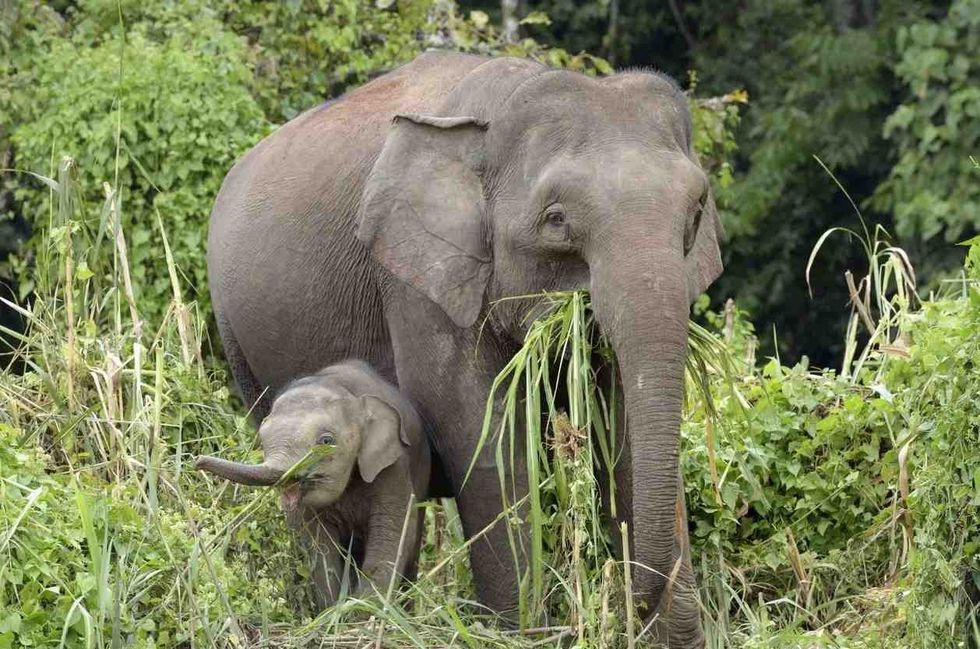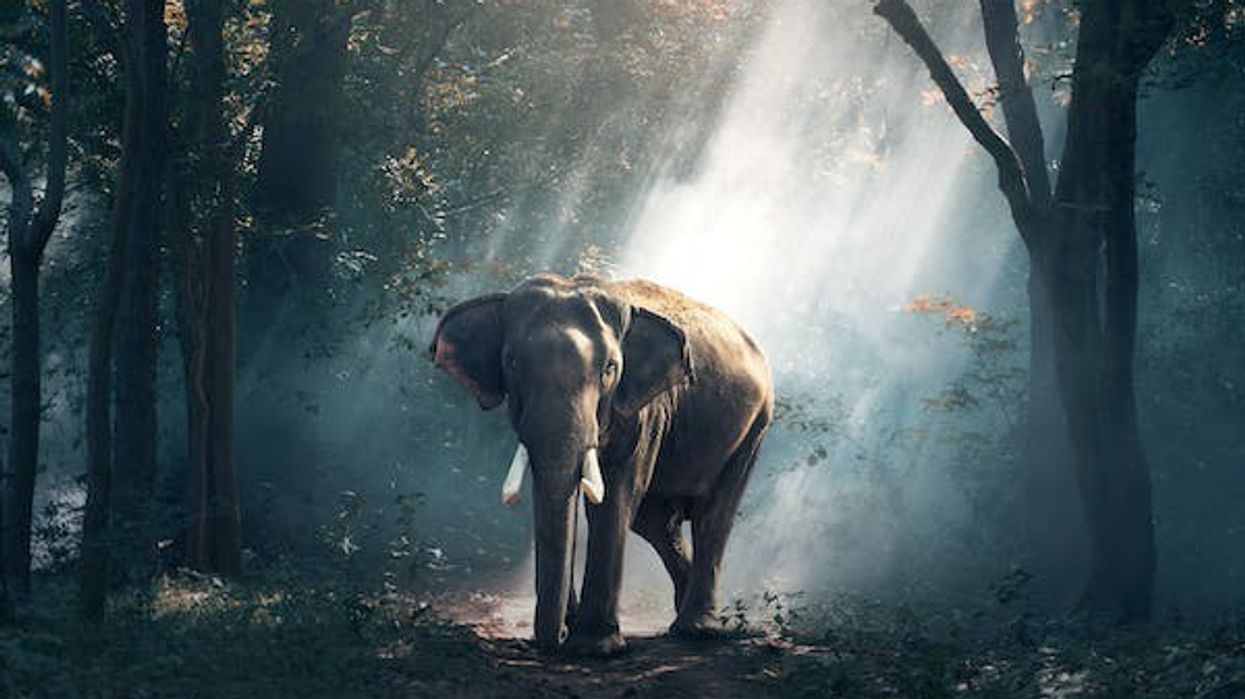Do you want to know about one of the smallest subspecies of Asian elephants that live in this world? Read on to know about the Borneo elephant, also known by its nickname, the Borneo pygmy elephant.
The tale goes that they were introduced in Borneo's forests by the Sultan of Sulu, who got it as a gift from the East Indian Company. However, the Sultan of Sulu story was recently debunked due to modern scientific advances.
This elephant habitat likely grew because of them crossing land bridges to reach Borneo from mainland Asia. Studies state that this population of animals must have crossed from mainland Asia about 18,000 years ago.
These studies also linked the Borneo elephant population to an evolution map that can be traced to 300,000 years ago. So, they aren't as new as you might think.
As a subspecies of the Asian elephant, they share similar characteristics. The rounded belly and large ears of the Borneo elephants make them look quite cute. They have straighter tusks compared to other elephants.
These elephants live mainly in Northeastern Borneo in the Sabah region. They like to reside in a low-lying habitat that has a river.
The population of the Borneo elephant is regarded as one of the smallest in the world. They can grow up to be 10 feet tall, which is similar to the Sumatran elephant.
These animals are herbivores, and they like to feed on grass and leaves. The Borneo elephant is also known as a calm and pleasant animal.
One of the threats that loom these smaller animals is that of the human-elephant conflict. According to the WWF, these elephants are facing an enormous habitat loss.
Elephants that may trespass into plantations and crop fields are often injured by illegal snares. Due to the dwindling number, elephant conservation of these species has taken place. The WWF also notes that in the last 40 years, about 60% of the Borneo elephants have faced habitat loss in Sabah.
They are currently listed as Endangered in the IUCN conservation list. Keep on reading to know more about the Borneo elephant facts.
To read more about interesting animals check out Sumatran elephant and Bornean orangutan facts.
Borneo Elephant Interesting Facts
What type of animal is a Borneo elephant?
A Borneo elephant or the Borneo pygmy elephant is a type of Asian elephant found on the Borneo island.
What class of animal does a Borneo elephant belong to?
A Borneo elephant (Elephas maximus borneensis) comes under the class of Mammalia and the family Elephantidae.
How many Borneo elephants are there in the world?
It is estimated that 1,500 Borneo pygmy elephants exist in the wildlife.
Where does a Borneo elephant live?
Borneo elephants prefer to stay in the lowland rainforests of Borneo, a Southeast Asian island shared by Malaysia, Indonesia, and Brunei. The Borneo pygmy elephant habitat is especially found in the areas of Kalimantan (Indonesia) and Sabah (Malaysia).
What is a Borneo elephant's habitat?
The Borneo elephants are mainly found in the North and Northwestern parts of the island. They are also found in the Lower Kinabatangan floodplain.
A Bornean elephant can spend 12-18 hours of its day roaming in the forest. Moreover, a seasonal migrational tendency has been observed in the Borneo elephant species, which helps them to keep up their rounded shape and good health.
Who do Borneo elephants live with?
Borneo pygmy elephants usually live in groups of up to eight individuals. The groups of the Bornean elephants are headed by female members. Borneo pygmy elephants are especially known for their gentle nature. They are even able to move through the forest without damaging a lot of vegetation.
How long does a Borneo elephant live?
The average lifespan of a Bornean elephant is 60-75 years.
How do they reproduce?
The reproduction of Borneo pygmy elephants has not been a part of extensive studies, but they do share common characteristics with the Asian elephants. The males go through something known as the 'musth' when they have the desire to mate.
The male elephants may participate in a fight with other elephants to get to a female Borneo pygmy elephant. Elephants have the ability to mate around the year.
However, when a female Bornean elephant usually vocalizes her desire to mate she prefers a strong and dominant partner. Female Borneo pygmy elephants have to raise the baby alone with her herd as the father elephants do not play any role.
Females can stay pregnant for 22 months or up to two years. They usually carry only one baby per pregnancy.
An elephant only gets pregnant at intervals of four to five years. It takes 10-15 years for an elephant to reach its sexual maturity.
What is their conservation status?
The Borneo pygmy elephant is enlisted as Endangered in the IUCN Red List. Their main threat to life is the loss of habitat.
According to World Wildlife Fund, about 20% of Bornean elephants residing in the forest of Lower Kinabatangan Wildlife Sanctuary of Sabah have been injured by humans due to them trespassing into palm oil plantations. With just 1,500 individuals of the species remaining in wildlife, strict conservation is needed.
Borneo Elephant Fun Facts
What do Borneo elephants look like?
The very first thing that makes Borneo elephants special is their smaller size. They are quite small compared to other Asian elephants.
It is also the reason for them to be regarded as Borneo pygmy elephants. The elephants have large ears and rounded bellies. A Borneo pygmy elephant does have a shorter trunk, and even the tusks in males are smaller compared to other elephants.
The tusks are missing or tiny in the case of female Borneo elephants. The rough and wrinkly skin of the Borneo pygmy elephants is covered with sparse hair, and they are usually gray in color. As elephants are fond of applying mud to their body, they can also appear to have a brownish color.
One of the distinct features of this elephant is its long tail which can even touch the ground. Additionally, the straighter tusks of Bornean elephants are also eye-catching.

How cute are they?
A Borneo elephant (Elephas maximus borneensis) is extremely cute. Their rounded belly and face shape gives them a cuter look. As one of the smallest Asian elephants present the Asian elephant subspecies look extremely cute in their childhood.
How do they communicate?
Like many other elephants, the Borneo elephants also communicate by making a low-frequency sound with the help of their tusks. The sounds are inaudible to the human ears. As an Asian elephant species, they can also communicate through movements and touch with their herd members. They also have the ability to make the usual high-frequency elephant-like sound.
How big is a Borneo elephant?
An average Borneo elephant grows up to the height of 6.5-10 ft (2-3 m). Even though this elephant subspecies is called 'pygmy', they grow up to be of the same size as a Sumatran elephant. However, a Borneo elephant is around 30% smaller than other bigger Asian elephants.
How fast can a Borneo elephant run?
A Borneo elephant can run at the average speed of 26 mph or 41 km/h. So, you shouldn't be fooled about their ability to run seeing their big size and adorable large ears.
How much does a Borneo elephant weigh?
One of the most interesting things about these animals has to be their weight. A Borneo pygmy elephant can grow up to have a weight of 6,500-11,000 lb (3000-5000 kg).
What are their male and female names of the species?
There are no distinct names for the female and the male elephants of the species.
What would you call a baby Borneo elephant?
A baby of the Borneo's is called a calf.
What do they eat?
Borneo elephants, the subspecies of an Asian elephant, are herbivores. Borneo elephants especially like to eat grass. However, other things that are part of their diet are fruits, flowers, crops, tree bark, grains, and leaves. These animals can go through up to 286 lb or 130 kg of food in a single day.
Are they aggressive?
Borneo elephants are known to be one of the most docile and peaceful subspecies of Asian elephants. They do not like to behave aggressively and are quite affectionate to the members of their herd.
They can even go through their usual routes without harming the smaller vegetation. However, a male pygmy elephant tends to behave aggressively when they are in 'musth'.
Would they make a good pet?
No. A Borneo elephant wouldn't make a good pet as they are meant to live in the wildlife.
A human being wouldn't be able to provide them a proper habitat like the forests that they call their home. Also, it is very tough to control a big animal like an elephant during its mating seasons. Technically it is also illegal to take a Borneo elephant as a pet.
Did you know...
The only Borneo pygmy elephant of the United States is present in the Oregon Zoo. The name of the female elephant is Chendra and she came to the zoo after being rescued from one of the oil palm plantations of the State of Sabah.
Why are Borneo elephants important?
Borneo elephants are important as they are one of the smallest subspecies of Asian elephants present in this world. Along with that, elephants do a great task of dispersing seeds along their way which in turn gives birth to many forests and helps to renew the environment.
Why are Borneo elephants endangered?
Borneo elephants have the status of being Endangered in the IUCN Red List. According to World Wildlife Fund (WWF), the main reason behind this is the human-elephant conflict over land.
These elephants reside on the island of Borneo, and as the human population rises, it mistreats the population of these pygmy elephants. The forests are being cleared out, which reduces the proportion of habitat and food sources that these elephants need.
When wildlife gets into palm oil plantations, Borneo's humans feel threatened and end up attacking these beings. As the humans encroach more space, the migration routes used by the elephant population seem to vanish.
Here at Kidadl, we have carefully created lots of interesting family-friendly animal facts for everyone to discover! Learn more about some other mammals including Balinese cat, or Sumatran orangutan.
You can even occupy yourself at home by drawing one on our Borneo elephant coloring pages.









